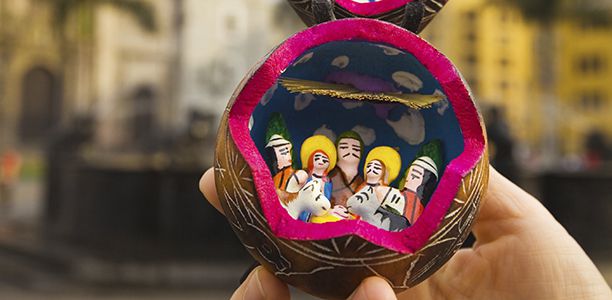Peru is a deeply religious, mostly Christian country so it is not surprising that Christmas, or Navidad, is celebrated by almost 100% of the population. It has become, as in many parts of the world, a very commercialised holiday but it’s also an important time to gather with the family members. Even people who don’t have family or can’t be with them for Christmas will be “adopted” by you for the holidays. Adopting families try to make their adopted members feel as much part of the family as everyone else.
Peruvian Christmas Facts
Christmas: Navidad
Date: The largest celebrations occur on Christmas Eve, 24th December
Santa Claus: Papa Noel
Christmas Eve: Nochebuena
Merry Christmas: Feliz Navidad
Christmas tree: Árbol de Navidad
Nativity: Nacimiento
Christmas preparations
The Christmas tree
Pine trees don’t grow in Peru, but decorating Christmas trees is an important part of Christmas celebrations. Many families will invest in a fake Christmas tree once or twice in their lifetime and keep it in storage until the season begins, in the first few days of December. Dusting off the tree, decorating it and putting up other Christmas ornaments is traditionally a whole family affair. Decorations outside of the house are less common especially in big suburban areas where high crime rates mean there’s a good chance of them being stolen.
Decorations often represent Christmas in the northern hemisphere, for example snowy landscapes, figures in winter clothes and snowmen, even though at this time of year it’s summer and usually about 30˚ in Peru!
Nativity
 Another major icon in every household in the lead up to Christmas is the Nativity Scene. Throughout the years these have evolved to include Peruvian motifs such as clothing, musical instruments and animals from the Andes region. Artisans handcraft every character with Andean features and these are quite popular not only during the holidays- most of them can be bought as souvenirs all year round.
Another major icon in every household in the lead up to Christmas is the Nativity Scene. Throughout the years these have evolved to include Peruvian motifs such as clothing, musical instruments and animals from the Andes region. Artisans handcraft every character with Andean features and these are quite popular not only during the holidays- most of them can be bought as souvenirs all year round.
Writing letters to Santa Claus
Letters to Santa, who lives in the North Pole, are sent out at the beginning of December. They can be posted by mail or even dropped off in convenient boxes located in many stores. Even though Santa is widely recognized as the official gift-bearer, some religious households like to bestow that honour to Baby Jesus, and therefore direct the letters to him.
Christmas Eve
In Peru the main event of the Christmas festivities is December 24th, Christmas Eve. It is known as a “half-holiday”, meaning that officially it is only a working day until noon. Businesses and shops close in the afternoon and the celebrations begin.
Christmas Eve dinner
 On Christmas Eve many Peruvian families get together and have dinner. Peruvians have many traditional foods which are well loved. But these are often set aside at Christmas celebrations; Christmas Dinner traditionally includes few of the well-known Peruvian staples. Instead it includes elements from different cuisines from around the world: turkey, mashed potatoes, stuffing, applesauce, cranberry sauce, pannetone and hot chocolate (although this is something of a Peruvian tradition). Of course the type of food varies from family to family and some may include different, more traditional dishes depending on their heritage. Peruvian ingredients may be included, especially nowadays that they are considered more of a delicacy.
On Christmas Eve many Peruvian families get together and have dinner. Peruvians have many traditional foods which are well loved. But these are often set aside at Christmas celebrations; Christmas Dinner traditionally includes few of the well-known Peruvian staples. Instead it includes elements from different cuisines from around the world: turkey, mashed potatoes, stuffing, applesauce, cranberry sauce, pannetone and hot chocolate (although this is something of a Peruvian tradition). Of course the type of food varies from family to family and some may include different, more traditional dishes depending on their heritage. Peruvian ingredients may be included, especially nowadays that they are considered more of a delicacy.
 Because families tend to be large in Peru, it is not unusual for these events to gather anything from 5 to 30 people at a time. Certain families will really go all out and hold a major party, usually starting at midnight after the praying and dining. It’s common to share an alcohol drink, play music and dance.
Because families tend to be large in Peru, it is not unusual for these events to gather anything from 5 to 30 people at a time. Certain families will really go all out and hold a major party, usually starting at midnight after the praying and dining. It’s common to share an alcohol drink, play music and dance.
Exchanging Christmas gifts
At midnight, most adults exchange presents, but children might need to wait till the next day if they can’t stay up that late (although almost everyone does).
Religious activities
On Christmas Eve it’s also common for families to attend Misa del Gallo, a mass service that starts at midnight, following Christmas Eve dinner.
Unveiling baby Jesus
Some families practice the tradition of covering or removing baby Jesus from the Nativity throughout the month of December and placing or unveiling him at midnight on the 24th. The family then gathers round the Nativity, usually holding sparklers (another must-have during the season), and pray to the newborn baby until the sparklers go out.
Fireworks
One of the most controversial of all Christmas traditions in Peru is fireworks. Except for a few types, they are readily available at stores and legal in Peru. Fireworks play a major part in the Christmas, and especially Christmas Eve celebrations. In the past few years there have been pleas for moderation as the noise in the city of Lima reaches that of a virtual war zone at midnight. Pet owners are at the forefront of this fight as dogs are the most affected by the noise, some of them having even died as a result of the commotion.
Christmas day
December 25th is a rather calm day. Some businesses might be open but for the most part it is a major holiday respected by all and families get to stay at home and be together, or go to visit other family members they did not get to see the night before.
For some kids it will be the day when they finally get to open their presents, so it’s also a day to play! Overall, it’s a day to spend and enjoy with the family without the running around of the previous evening.
Santa Claus – Papá Noel
Father Noel (if you translate his name in English) is a popular figure in Peru. He is everywhere, in every single advertising campaign, school Christmas celebration, shopping centre and show. Although very religious households bestow the honour of gift-giving to the figure of Baby Jesus, Papá Noel is widely regarded by kids as the official gift bearer and almost all letters are directed to him. Having said this, every family goes through different degrees of trouble to keep the secret alive.
Some families will lay the presents under the tree on the 24th but are careful not to include the kids’, or for the kids they’ll have little tags claiming the present is “from: Papá Noel”, even if the rest of tags have the name of other family members. Other households might get a little more creative and wait till the 25th for the children’s sake. Yet at one point or another kids will receive some presents from other adults as well. This can be somewhat confusing and burst the Santa bubble at quite a young age. Still, Papá Noel is one of the major icons during the holidays.
Post Christmas
As it is summer in Peru during the festivities, and therefore vacation time for all children, many families in the coastal cities (budget permitting) will rent a house on one of the numerous beaches. Even if renting is not an option, some opt to go camping. The idea is to welcome the New Year by the sea, where most beach towns have big parties and celebrations.
Read More
 |
Find out about Christmas celebrations in other parts of the world. |



 (6 votes, average: 4.33 out of 5)
(6 votes, average: 4.33 out of 5) 






